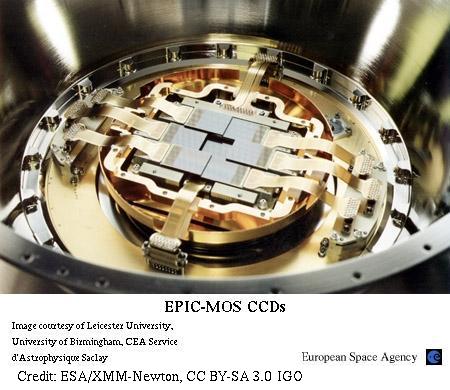EPIC-MOS CCDs

Minimum credit line: Image courtesy of Leicester University, University of Birmingham, CEA Service d'Astrophysique Saclay and ESA. (for details, see Conditions of Use).
Credit: ESA/XMM-Newton, CC BY-SA 3.0 IGO
The image above can be displayed at full size and may be downloaded by clicking the image above.
| About this Image |
|---|
Photography of the array of 7 CCDs of an EPIC MOS camera. The two MOS cameras are arranged on the spacecraft focal plane bulkhead so that the CCDs are orthogonal. This means that the 300 micron gaps between the outer CCDs in one camera are covered by their opposite numbers in the other camera.
| For More Information |
|---|
- Read the Journal article
- Visit related website;
http://xmm.esac.esa.int/external/xmm_user_support/documentation/technical/EPIC/index.shtml - Detailed description of this image
- For unfamiliar terms, visit the XMM-Newton Astronomical Glossary
| Detailed Caption | There are seven EEV type 22 front-illuminated CCDs in the focal plane of each MOS camera. The central CCD is at the focal point on the optical axis of the telescope while the outer six are stepped towards the mirror by 4.5 mm to follow approximately the focal plane curvature, and improve the focus for off-axis sources. The CCDs are buttable with a dead region of less than 300 microns wide on three sides; to minimise the dead space, adjacent CCDs are stepped by about 1 mm to overlap by 300 microns. The imaging area is ~2.5 x 2.5 cm, so that a mosaic of seven covers the focal plane 62 mm in diameter, equivalent to 28.4 arcmin. The imaging section has 600 x 600, 40 micron square, pixels; one pixel covers 1.1 x 1.1 arcsec on the FOV; 15 pixels cover the mirror PSF half energy width of 15 arcsec. The readout register is split into two sections, ending in a readout node. The full CCD image can be read out using either node, or read out using both nodes simultaneously, to halve the readout time. The two MOS cameras are arranged on the spacecraft focal plane bulkhead so that the CCDs are orthogonal. This means that the 300 micron gaps between the outer CCDs in one camera are covered by their opposite numbers in the other camera. |
| Alternate Resolutions | (Help) |
|---|
This image is available in the following downloadable versions: Higher resolution versions of this image may be available, please contact the XMM-Newton HelpDesk.
Search the Image Gallery
To search the Image Gallery for a particular object, fill in the object name in the box below and click the Submit button.To search the Image Gallery for other images, fill in any of the fields below and click the Submit button.
For more search options, please use our Advanced Search form.